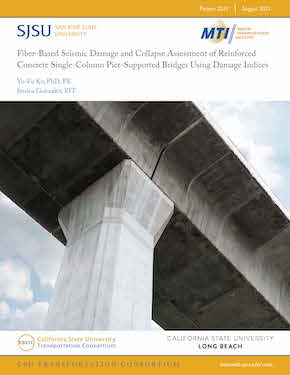- 408-924-7560
- mineta-institute@sjsu.edu
- Donate
Fiber-Based Seismic Damage and Collapse Assessment of Reinforced Concrete Single-Column Pier-Supported Bridges Using Damage Indices
Near-fault earthquakes can have major effects on transportation systems due to the structural damage they impose on bridges. Therefore, it is imperative to assess the seismic damage of bridges appropriately, and this research focuses on reinforced concrete (RC) bridges. This research advances the seismic performance assessment of RC single-column pier-supported bridges with flexural failure under near-fault ground motion by use of ductility coefficients and damage indices. The methodology included modeling fiber-based nonlinear beam-column elements to simulate the damage development process of RC bridge piers under earthquake loadings, considering the global buckling of longitudinal steel bars, examining the cracking and spalling of cover concrete, and analyzing the effects of bond-slip. The tensile strain represented the damage of the longitudinal bars while the compression strain represented the cover concrete damage. Two innovative nonlinear fiber-based finite element models (FEMs) were developed: Model 1 (bond-slip excluded) and Model 2 (bond-slip included). Nonlinear static cyclic pushover analyses and nonlinear response history analyses were conducted. The simulation results were compared with available pseudo-dynamic test results. Model 1 provided a more ideal prognosis on the seismic performance of RC single-column pier-supported bridges under near-fault ground motion. The proposed damage indices can indicate the damage state at any stage and the gradual accumulation of damage in RC bridge piers, which are more convincing than most other indices in the literature. The proposed fiber-based nonlinear FEMs, together with the use of ductility coefficients and proposed damage indices, can also assist engineers and researchers in simulating the seismic behavior and assessing the damage state of RC bridge columns in a computationally effective manner which can empower engineers to identify and prioritize RC bridges for seismic retrofit and maintenance.
YU-FU KO, PHD, PE
Dr. Ko joined the California State University, Long Beach (CSULB) Civil Engineering and Construction Engineering Management Department in Fall 2009. He received his B.S. degree in Structural Engineering from National Taiwan University of Science and Technology and his M.S. and Ph.D. degrees (as an outstanding Ph.D. award recipient) in Civil Engineering, focusing on Structural Mechanics and Structural Engineering/Dynamics from the University of California, Los Angeles (UCLA). Prior to joining CSULB, Dr. Ko was a postdoctoral researcher and lecturer at UCLA and a senior structural design engineer at Englekirk and Sabol Consulting Structural Engineers, Inc. He is a registered Professional Civil Engineer in the state of California. Dr. Ko's areas of research include micro/nano-mechanics modeling of heterogeneous composite materials, micromechanical damage mechanics modeling and associated applications, damage assessment and experimental mechanics of structural materials, nonlinear/linear structural dynamic analysis of structures subjected to earthquake motions, finite element method code-based and performance-based structural design of structures, and seismic retrofitting of existing structures. He has presented at national and international conferences and published research papers in national and international peer-reviewed journals. He actively participates in ASCE, ASME, AISC, ACI, SEAOSC, IACM, USACM, and other national and international societies. He is also a peer reviewer for numerous technical journals.
JESSICA GONZALEZ, EIT
Jessica Gonzalez is a research graduate assistant working with Dr. Yu-Fu Ko at California State University, Long Beach (CSULB). She received her B.S. in civil engineering from CSULB with Cum Laude degree honors and is currently enrolled as a graduate student working towards her master’s degree. She is certified as an Engineer-in-Training (EIT) and is currently employed as a structural designer at RailPros, Inc. Her research interests are finite element modeling of bridges and the seismic analysis of bridge components. Additionally, her software skills include AutoCAD and OpenSees.
-
Contact Us
San José State University One Washington Square, San Jose, CA 95192 Phone: 408-924-7560 Email: mineta-institute@sjsu.edu






